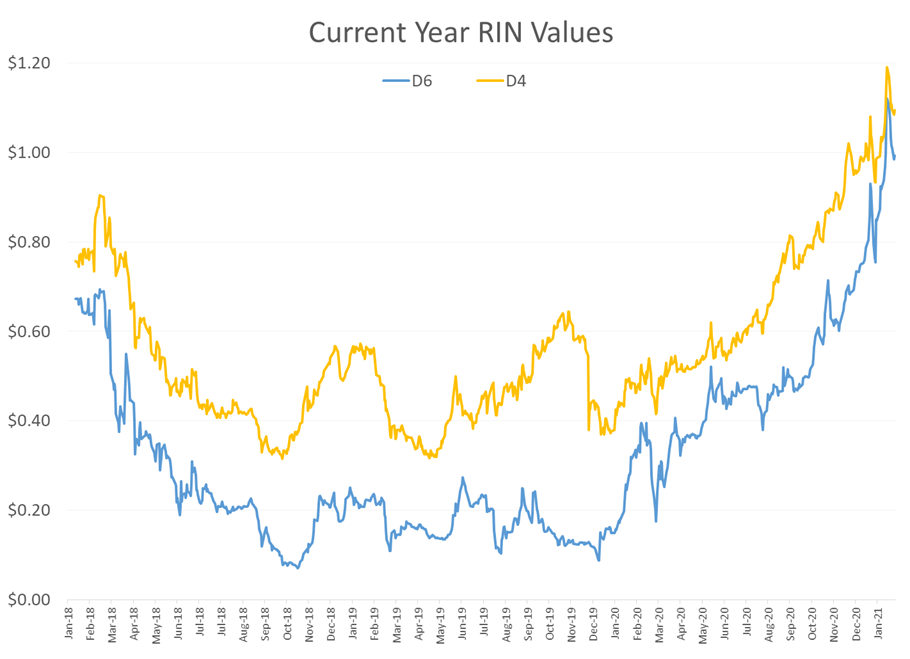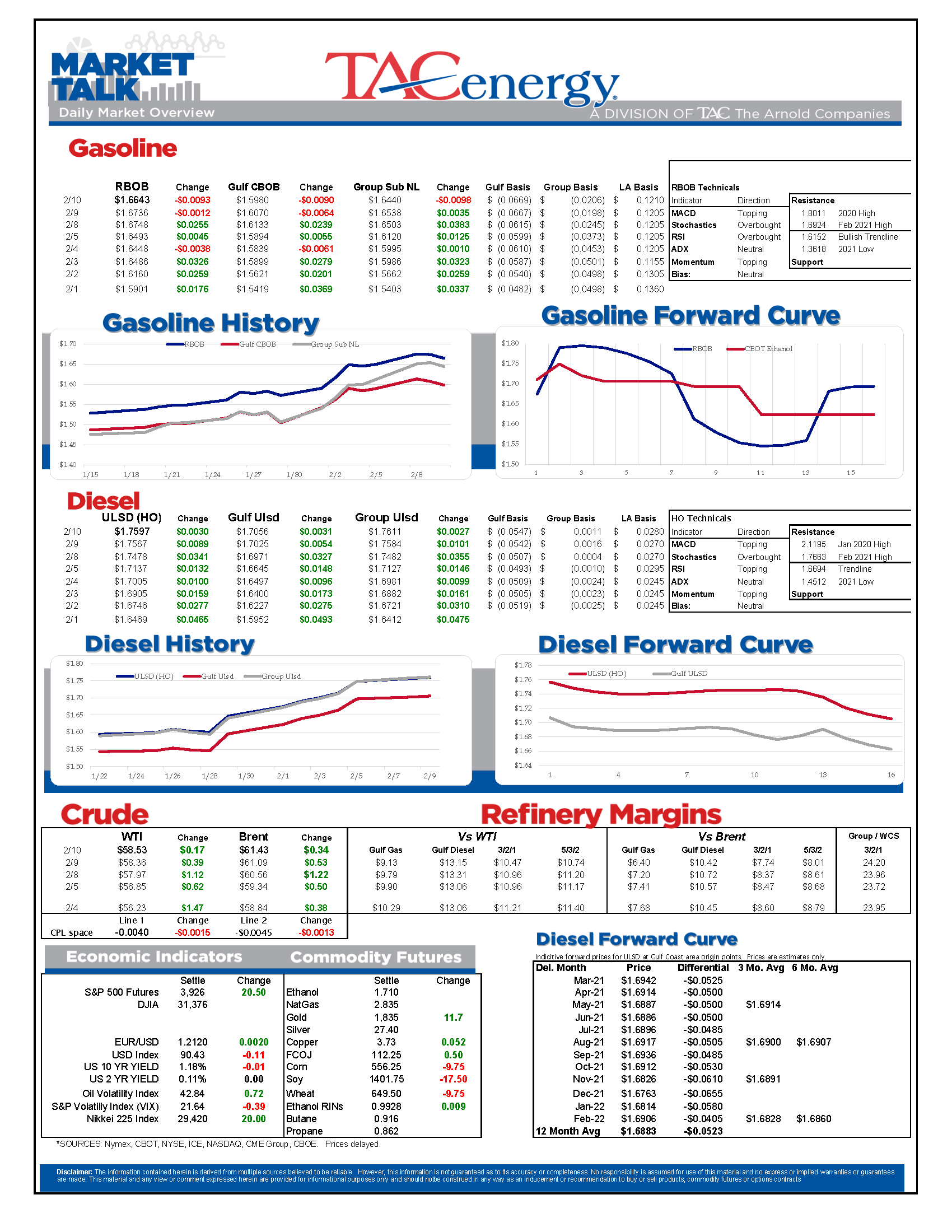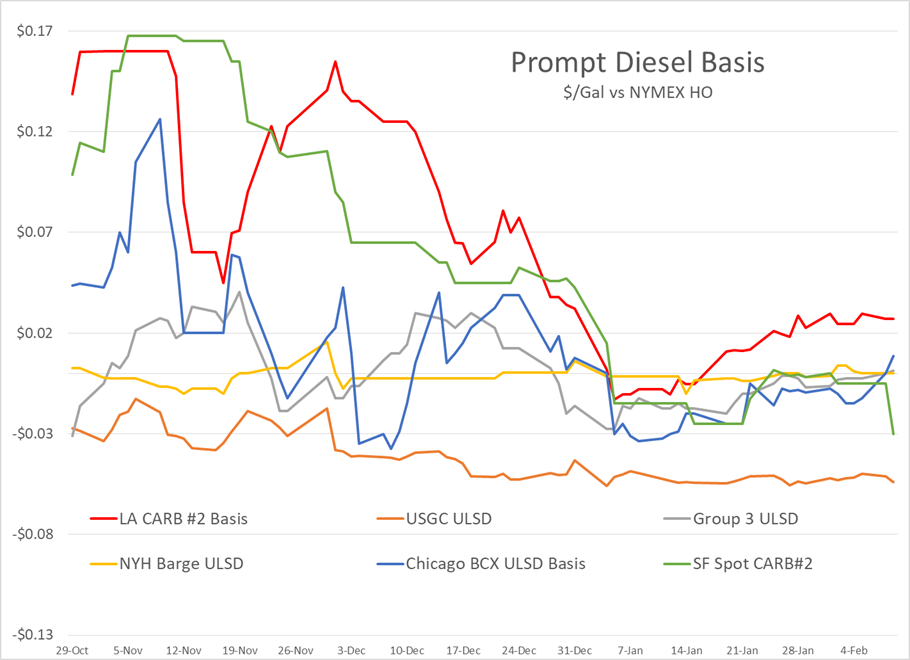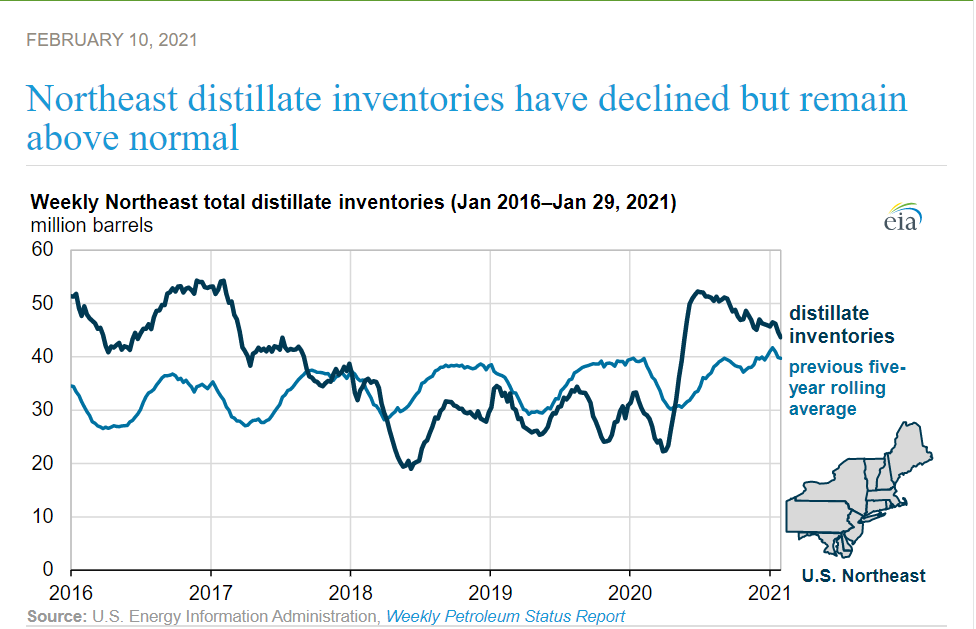Parade Of Winter Storms Hits Demand Across The Country

Oil and diesel prices are moving higher for an eighth straight day after Tuesday morning’s attempted sell-off proved to be short-lived. RBOB prices are struggling to keep up so far after a large build in U.S. gasoline inventories gave traders reason to pause. Tuesday’s bounce keeps the bullish trend lines intact, and the path open to test the 2020 highs set before COVID lockdowns became a reality even as more fundamental signs suggest this rally may have outkicked its coverage.
The API was reported to show a 3.5 million barrel draw in oil inventories last week, while distillates declined by just under ½ million barrels. A large build in gasoline stocks of 4.8 million barrels seems to be the reason that the March RBOB contract is the only one of the big 4 petroleum futures trading in the red this morning, while the others add modest gains. The DOE’s weekly status report is due out at its normal time this morning, with the gasoline demand number sure to be closely watched as a parade of winter storms has hit demand across most of the country in the past two weeks.
Speaking of winter weather, a major cold snap is bringing temperatures well below normal for this time of year to a wide area of the country. Already, there are reports that several utilities are putting customers on notice that this could mean curtailments in natural gas availability due to a spike in heating demand. In years past this would often mean a spike in ULSD prices as heating oil demand for homes, and dyed diesel demand for power plant supplemental fuel. While we’ve been in the midst of a very strong rally in ULSD prices the past three months, this latest cold snap doesn’t appear to be doing much so far to add more fuel to the rally, with basis and time spreads hardly reacting over the past several days. A note this morning from the EIA may help explain why as the U.S. Northeast is still sitting on inventory levels for diesel that are well above normal levels.
The latest in the long line of refining casualties in the past year: Exxon announced it is closing one of the three remaining refineries in Australia, despite efforts from the government to bridge the gap until demand picks back up.
The Chevron refinery in Richmond, CA had a spill near its wharf in the San Francisco bay, but it appears that leak was contained, and given its relatively small size of around 600 gallons should not be a major issue for the bay area, or the refineries operations unless additional damage is discovered during the investigation. Bay area fuel diffs have been under heavy pressure lately as local shutdown orders continue to hamper fuel demand.
RIN markets have been relatively quiet this week after several weeks of wild trading as the political football known as the RFS continued to be punted back and forth in Washington. This week the EPA is hearing testimony on a proposed plan by the previous administration to extend the deadlines for complying with the RFS for 2019 and 2020, although a final ruling on that matter isn’t expected until the spring.
Click here to download a PDF of today's TACenergy Market Talk.
Latest Posts
The Sell-Off Continues In Energy Markets, RBOB Gasoline Futures Are Now Down Nearly 13 Cents In The Past Two Days
Week 15 - US DOE Inventory Recap
Prices To Lease Space On Colonial’s Main Gasoline Line Continue To Rally This Week
Equity Markets Have Been Pulling Back Sharply In Recent Days As Inflation And Trade Concerns Inject A Sense Of Reality Into Stocks
Social Media
News & Views
View All
The Sell-Off Continues In Energy Markets, RBOB Gasoline Futures Are Now Down Nearly 13 Cents In The Past Two Days
The sell-off continues in energy markets. RBOB gasoline futures are now down nearly 13 cents in the past two days, and have fallen 16 cents from a week ago, leading to questions about whether or not we’ve seen the seasonal peak in gasoline prices. ULSD futures are also coming under heavy selling pressure, dropping 15 cents so far this week and are trading at their lowest level since January 3rd.
The drop on the weekly chart certainly takes away the upside momentum for gasoline that still favored a run at the $3 mark just a few days ago, but the longer term up-trend that helped propel a 90-cent increase since mid-December is still intact as long as prices stay above the $2.60 mark for the next week. If diesel prices break below $2.50 there’s a strong possibility that we see another 30 cent price drop in the next couple of weeks.
An unwind of long positions after Iran’s attack on Israel was swatted out of the sky without further escalation (so far anyway) and reports that Russia is resuming refinery runs, both seeming to be contributing factors to the sharp pullback in prices.
Along with the uncertainty about where the next attacks may or may not occur, and if they will have any meaningful impact on supply, come no shortage of rumors about potential SPR releases or how OPEC might respond to the crisis. The only thing that’s certain at this point, is that there’s much more spare capacity for both oil production and refining now than there was 2 years ago, which seems to be helping keep a lid on prices despite so much tension.
In addition, for those that remember the chaos in oil markets 50 years ago sparked by similar events in and around Israel, read this note from the NY Times on why things are different this time around.
The DOE’s weekly status report was largely ignored in the midst of the big sell-off Wednesday, with few noteworthy items in the report.
Diesel demand did see a strong recovery from last week’s throwaway figure that proves the vulnerability of the weekly estimates, particularly the week after a holiday, but that did nothing to slow the sell-off in ULSD futures.
Perhaps the biggest next of the week was that the agency made its seasonal changes to nameplate refining capacity as facilities emerged from their spring maintenance.
PADD 2 saw an increase of 36mb/day, and PADD 3 increased by 72mb/day, both of which set new records for regional capacity. PADD 5 meanwhile continued its slow-motion decline, losing another 30mb/day of capacity as California’s war of attrition against the industry continues. It’s worth noting that given the glacial pace of EIA reporting on the topic, we’re unlikely to see the impact of Rodeo’s conversion in the official numbers until next year.
Speaking of which, if you believe the PADD 5 diesel chart below that suggests the region is running out of the fuel, when in fact there’s an excess in most local markets, you haven’t been paying attention. Gasoline inventories on the West Coast however do appear consistent with reality as less refining output and a lack of resupply options both continue to create headaches for suppliers.

Week 15 - US DOE Inventory Recap

Prices To Lease Space On Colonial’s Main Gasoline Line Continue To Rally This Week
Energy markets are sliding lower again to start Wednesday’s trading as demand concerns and weaker stock markets around the world seem to be outweighing any supply concerns for the time being.
Rumors continue to swirl about an “imminent” response by Israel to Iran’s attacks, but so far, no news seems to be taken as good news in the hopes that further escalation can be avoided, even as tensions near the Red Sea and Strait of Hormuz continue to simmer.
Prices to lease space on Colonial’s main gasoline line continue to rally this week, trading north of 11 cents/gallon as Gulf Coast producers still struggle to find outlets for their production, despite a healthy export market. Gulf Coast CBOB is trading at discounts of around 34 cents to futures, while Gulf Coast RBOB is trading around a 16-cent discount, which gives shippers room to pay up for the linespace and still deliver into the East Coast markets at a profit.
Back to reality, or just the start of more volatility? California CARBOB basis values have dropped back to “only” 40 cent premiums to RBOB futures this week, as multiple flaring events at California refineries don’t appear to have impacted supply. The state has been an island for fuel supplies for many years as its boutique grades prevent imports from neighboring states, and now add the conversion of the P66 Rodeo refinery to renewable diesel production and the pending changes to try and cap refinery profits, and it’s easier to understand why these markets are increasingly vulnerable to supply shocks and price spikes on gasoline.
RIN prices continue to fall this week, touching 44 cents/RIN for D4 and D6 values Tuesday, their lowest level in 6 weeks and just about a nickel above a 4-year low. While the sharp drop in RIN and LCFS values has caused several biodiesel and Renewable Diesel producers to either shut down or limit production, the growth in RIN generation continues thanks to projects like the Rodeo refinery conversion, making the supply in RINs still outpace the demand set by the Renewable Fuel Standard by a wide margin.
The API reported draws in refined products, 2.5 million barrels for gasoline and 427,000 barrels for distillates, while crude oil stocks had an estimated build of more than 4 million barrels. The DOE’s weekly report is due out at its normal time this morning.
Click here to download a PDF of today's TACenergy Market Talk.



